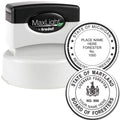Have you ever looked at a plain T-shirt, handbag, or even throw pillows and wished you could give them a fun, custom touch without spending a fortune? That is where fabric markers come in. They let you add personalized designs, names, or vibrant doodles to virtually any textile you own. Best of all, they are simple to work with, making them perfect for both beginners and seasoned DIY enthusiasts. In this guide, we will explore handy tips for using these handy markers, compare them to stamps, and suggest ways to ensure your creations stay sharp wash after wash.
Understand Fabric Markers
Fabric markers are designed for drawing, lettering, and decorating on cloth, making them ideal if you want to spruce up your shirts, tote bags, or kid’s clothing. Many of them use permanent ink that bonds to your fabric’s fibers, so your design typically holds up through laundry cycles and everyday wear.
- Permanent Ink: Most markers include a formula that resists fading.
- Tip Variety: You will find different tip shapes, from fine points for detailed outlines to broad tips for large fill areas.
- Fabric-Friendly Pigments: Colors are more likely to remain vibrant, especially when properly heat-set.
The great thing here is that these markers let you explore your creative side—without fancy tools or a major budget. All you need is clean fabric, a design in mind, and a little time.
Know Marker Types
When selecting your maker tools, it helps to know what sets various kinds of markers apart. You will see differences in:
Ink Formulation
- Alcohol-Based: Rapid-drying, often stays vivid even on darker materials.
- Water-Based: Softer colors that can blend nicely, useful for pastel designs.
Tip Shape
- Fine: Perfect for outlines, names, and smaller decorative touches.
- Chisel: Great for broad strokes and filling larger areas fast.
- Brush: Mimics paintbrush strokes, giving you a painterly aesthetic.
Color Range
Some sets come with just the basic rainbow, while others include metallics, neons, or fabric-safe glitter options. If you like bold, eye-catching looks, you might lean toward neon or metallic sets. For subtler decorations, a core set of primary tones could be all you need.
Prep Your Fabric
Before popping open your markers, you will want to set yourself up for the best possible results. Fabric that has just been sitting in your closet might carry dust, oils, or loose fibers. Giving it a bit of prep helps your designs stick better.
- Wash and Dry: Launder the item to remove sizing (a chemical finish used in new garments) or any dirt. Skip the fabric softener and dryer sheets because they can coat fibers, making ink less absorbent.
- Smooth the Surface: Iron out wrinkles so you have a flat surface to draw on. This step helps you avoid crooked lines or uneven color application.
- Set Up a Barrier: Place cardboard or thick paper between layers of fabric to stop ink from bleeding through to the back. An old magazine also does the trick if you are in a pinch.
Practice And Test
Even if you have some drawing experience, it is wise to do a quick test on a scrap piece of material first. That way, you can see how the marker glides, how quickly it dries, and whether it bleeds. Trying out your technique before writing directly on your favorite hoodie can save you headaches later.
Quick Testing Tips
- Check Various Colors: Some fabrics absorb ink more quickly, so see if darker hues bleed more than lighter ones.
- Explore Pressure and Angles: A heavier hand might lead to thicker, more saturated lines.
- Layering Colors: See if layering different shades creates new tints or if it just makes the fabric soggy.
Once you feel comfortable with your marker control, go ahead and outline your project on the real item. If you are confident in freehand drawing, that is awesome, but a quick pencil sketch or chalk outline works if you want a safety net.
Seal Your Designs
For many permanent markers, a simple round of ironing helps lock in the color:
- Turn Inside Out: Flip the fabric so you iron the back side of the marker artwork.
- Medium Heat: Aim for the best setting for your particular fabric, usually medium to high for cotton, medium for blends.
- Move Regularly: Glide the iron over the area for 3 to 5 minutes, checking edges to ensure even heating.
When your material is cool, flip it back around and admire your sealed design. This step helps the ink penetrate deeper, boosting its chances of holding up through multiple washes.
Try Different Techniques
Sure, you can just draw a picture or scrawl your name, but if you are looking for something more polished or playful, experiment with a few creative approaches:
Stencils
Grab official stencils from a craft store or make your own by cutting shapes out of cardstock. Stencils give you crisp edges for letters, silhouettes, and geometric shapes.
Blending
If your markers are water-based, you can use a slightly damp brush to blur or blend colors. This technique works well for an ombré effect—like shading from sunny yellow to orange in a sunset scene.
Layering
Let each color dry thoroughly before adding the next. This method is fantastic for building depth in larger designs, such as animals or floral patterns. It is a bit time-consuming, but the payoff in color intensity can be amazing.
Stamps Versus Markers
While fabric markers are ideal for freehand designs and lettering, sometimes you want clean, replicated shapes. That is where stamps come in—especially if you plan to mark multiple clothes or want a uniform look across several items.
- Consistency: A fabric stamp ensures each impression looks the same.
- Speed: Once set up, stamping large batches of clothing (like team shirts or kid’s camp uniforms) goes quickly.
If you prefer a tool that can replicate logos or text an unlimited number of times, go with a quality stamp. Markers, in contrast, are best for custom doodles or purely artistic expressions where each piece will be unique.
ESS Stands Out
Looking to take your custom clothing game to a whole new level? ESS is a top supplier of cloth marking stamps, clothes name stamps, and fabric stamps, with a reputation for stellar customer service. Family owned and operated since 1964 (that is 60 years and counting), ESS knows exactly what customers appreciate:
- Wide Selection: Because different projects call for different tools, ESS offers plenty of choices, from stamps to ink refills.
- Super Fast Turnaround: If you have a looming deadline or big event, speedy processing can be a lifesaver.
- Friendly Guidance: Unsure which marking method is best for your fabric? You can reach out to ESS for personal tips, ensuring you pick the right tool.
So if you are serious about easy, top-quality fabric marking, ESS stands ready to help you with markers, stamps, and beyond.
Final Thoughts
Fabric markers have earned their place in any crafter’s toolbox because they are easy to use, mess-free, and capable of turning an ordinary garment into something memorable. Some folks love them purely for personalizing T-shirts, while others rely on them to label fabric items for school or work. And if you want a pre-made design or uniform imprint, remember that a fabric stamp is a go-to option for crisp, repeatable results.
No matter which tool you choose, a little setup time and heat-sealing go a long way in keeping your design vibrant day after day. Take advantage of the variety of marker tips and colors, get messy, and discover your own artistic style. If you ever need advice or a trustworthy stamp source, you know where to find ESS.
FAQs
1. Will Fabric Markers Wash Out Over Time?
A quality brand of markers, combined with proper heat-setting, generally keeps your design in place for many washes. Turn garments inside out before laundering, and use moderate cycles to preserve color vibrancy.
2. What Is the Best Way to Remove Mistakes?
If you spot a fresh mistake, a damp cloth might lift some of the ink, especially if it is water-based. However, for permanent pigments, complete removal can be tricky. Consider covering the error with a new design element.
3. Can I Use Fabric Markers on Dark Materials?
Yes, but you will want to pick markers labeled for dark fabrics or choose metallic and neon sets that show up better on black or navy material. Always do a test swatch so you know what your final color will look like.
4. Do I Need Special Detergent for Marker-Decorated Clothes?
Generally, no. A gentle, cold-water wash cycle with a standard detergent should suffice. Avoid harsh chemicals or bleach since they can weaken the ink bond.
5. What Makes ESS a Top Choice for Fabric Marking?
ESS has spent decades perfecting cloth marking tools, including stamps and specialized inks. Their family-owned approach means you get personalized, friendly service, plus super quick turnaround times for every order. If you are not sure what works best on your fabric, just ask. They will guide you step by step.
Whether you are decorating a tote bag or labeling uniforms for a big event, fabric markers let you get creative and practical all at once. Feel free to experiment, trust your instincts, and remember that ESS is around to back you up whenever you need an expert hand. Have fun bringing your one-of-a-kind designs to life!


















